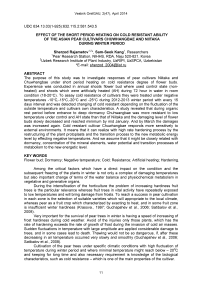Effect of the short period heating on cold resistant ability of the Asian pear cultivars Chuwhangbae and Niitaka during winter period
Автор: Rajametov Sherzod, Kang Sam-Seok
Журнал: Вестник аграрной науки @vestnikogau
Статья в выпуске: 2 (47), 2014 года.
Бесплатный доступ
The purpose of this study was to investigate responses of pear cultivars Niitaka and Chuwhangbae under short period heating on cold resistance degree of flower buds. Experience was conducted in annual shoots flower bud where used control state (non-heated) and shoots which were artificially heated (AH) during 72 hour in water in room condition (18-20°С). To assay cold resistance of cultivars they were treated under negative temperatures -10°С,-15°С,-20°С and -25°С during 2012-2013 winter period with every 15 days interval and was detected changing of cold resistant depending on the fluctuation of the outside temperature and cultivars own characteristics. A study revealed that during organic rest period before entrance to deep dormancy Chuhwangbae was more resistant to low temperature under control and AH state than that of Niitaka and the damaging level of flower buds slowly decreased and reached minimum by mid January. And by March the damages was increased again. Cold resistant cultivar Chuwhangbae responds more sensitively to external environments. It means that it can realize with high rate hardening process by the restructuring of the plant protoplasts and the transition process to the new metabolic energy level by effecting negative temperatures. And we assume that it might be closely related with dormancy, concentration of the mineral elements, water potential and transition processes of metabolism to the new energetic level.
Flower bud, dormancy, negative temperature, cold, resistance, artificial heating, hardening
Короткий адрес: https://sciup.org/147124531
IDR: 147124531 | УДК: 634.13.03(1-925):632.115.2:581.543.5
Текст научной статьи Effect of the short period heating on cold resistant ability of the Asian pear cultivars Chuwhangbae and Niitaka during winter period
Among the critical factors which have a direct impact on the condition and the subsequent freezing of the plants in winter is not only a complex of damaging temperatures but also important change of terms of the water balance and physiochemical metabolism in vegetative and generative organs.
During the intensification of the horticulture the problem of increasing hardiness fruit trees is the particular relevance whereas fruit trees in vital activity have repeatedly exposed to low temperatures and will bring damage from frosts. To reach a success in pear cultivation in each zone is the selection of suitable varieties which will appropriate to the local climate, whereas pear as a fruit crop which characterized by exacting to heat, and in some fruit zone is insufficient winter hardiness (Krasova., 1997; Guchapshev et al., 2006; Satibalov et al., 2008).
Very important for the survival of pear trees in winter is having a speed of increasing of frost hardiness during cold weather. Avoid of the injuries only those plants, which has the rate of hardening exceeds the rate of growth of frost during the invasion of cold air masses. Sudden fluctuations in temperature with large amplitude are applied considerable damage to trees, and in some cases lead to death. Thawing would not be so dangerous, if, after these decreasing in air temperature occurred very slowly and smoothly (Guchapshev et al., 2006; Satibalov et al., 2008).
Cultivation of the pear trees under specific climatic conditions with high fluctuation of temperature during winter period and where minimal temperature might reach below – 200C and keeping for long time and also necessary requirement is knowledge of the biological characteristics, such as cold resistance – which is one of the main properties of the cultivar.
A variety of physiological and biochemical alterations, such as changes in carbohydrate, lipid and protein composition, water status in plant have been correlated with cold acclimation, upon occurrence of negative temperature increase of sugars in plant tissues is largely a result of hydrolysis of starch and associated with cold hardness (Steponkus and Webb, 1992; Sperry, 1993; Sparks et al., 2001; Zhang, 2006; Lee, 2011). During this period, especially is important in plants, the accumulation of significant amounts of a special type of sugar. These substances hinder the appearance of ice crystals in the cells when severe frosts and slows their growth (Ashworth, 1992; Norman et al., 1995; Sugiura., 2002; LIU., et al., 2007; Satibalov et al., 2008), although a clear role for any of these changes in development of freezing tolerance is yet to be demonstrated. Consequently, accumulation of proteins has been suggested to play a role in the observed increase in freezing tolerance (Mohapatra et al., 1987; Perras and Sarhan, 1989; Alehina et al., 2005). However, most of the injury results from the severe cellular dehydration that occurs with freezing (Levitt, 1980a; Steponkus and Webb, 1992).
The mechanisms responsible for freezing tolerance (Thomashow, 1998) and inhibition of growth during the deep dormancy are not completely clear. Some researchers tend to attribute this phenomenon to Naringenin and Abscisic acid (ABA) as specific substances with extensive inhibitory effect and freezing-tolerant (Genkel et al., 1964; Likhonos et al., 1983; Grossi et al., 1992; Lang et al., 1994, Thorlby et al., 2004; Lata and Prasad, 2011).
Nevertheless, the role of ABA in low-temperature- responsive gene expression is not clear (Thomashow, 1999; Shinozaki and Yamaguchi-Shinozaki, 2000). Although several genes are induced in response to dehydration and cold stress on exogenous ABA treatment (Zhu, 2002; Shinozaki et al., 2003; Lata and Prasad, 2011), there are also many genes that do not respond to such treatments (Ingram and Bartels, 1996; Shinozaki and Yamaguchi-Shinozaki, 1997; Zhu, 2002; Yamaguchi-Shinozaki and Shinozaki, 2005) suggesting the existence of both ABA-dependent and -independent signal transduction cascades. DRE/CRT is one of the major cis -acting elements which function in ABA-responsive or non-responsive gene expression during abiotic stresses (Nakashima and Yamaguchi-Shinozaki, 2010; Lata and Prasad, 2011). ABA can substitute for the low temperature stimulus, provided there is also an adequate supply of sugars and there may be ABA-dependent and ABA-independent pathways involved in the acclimation process (Gusta et al., 2005).
Therefore, winter hardiness - this is one of the most important properties of the fruit crops, limiting their successful cultivation and is very important to find ways to limiting of injury by frosts and study the possibility of plant adaptation to adverse conditions.
Analysis of literature shows that the resistance of plants to cold is depending on many factors. Therefore, this experience purpose was to find out – response of the pear cultivars on the artificial heating during winter period and effect on the flower buds injury level.
MATERIALS AND METHODS
This experience was done in Pear research station, NIHHS, RDA Republic of Korea. Definition of the cold tolerance of flower buds, we used 2 cultivars of Pyrus pyrifolia-Chuwhangbae and Niitaka under 2 state: artificial freezing of the annual shoots directly from the field as control and second one is freezing of the annual shoots after artificial heating treatment (shoots were kept 72 hours under maintaining in the water and temperature was 18-20 ° C).
In each investigation were used 3 replication and each shoots had at least 15-18 flower buds (each shoot must be about 0.80 – 1.0 m length and diameter 0.7-1.0 mm).
For freezing of annual shoots was used refrigerator (SJ-501GM-LED). Annual shoots with flower buds in control and AH state was started hardening from temperature 0°C and kept for 6 hours, and then the temperature was slowly decreased during an hour until -2 °C and held for 2 hours. On third hours of freezing under -2 °C start freezing on the adopted scheme, decreasing the temperature at -2 °C per hour until a certain fixed temperature (for example fixed -10 °C and kept for 4 hours from -2 to -10°C). When the temperature reached the fixed level -10 °C the shoots were kept during 6 hours. After freezing in the refrigerator the temperature start to slowly rise to 0 °C by using 2 °C per hour. At zero temperature shoots were kept at least 6 hours to complete their thawing. Hereinafter, the temperature was raised slowly each 1 hour + 2°C to room temperature and transferred shoots into container with water for saturation. Shoots were kept at room temperature during 2 days to make account damage. To do this, make a cut section of flower buds, and determine the extent of the damage. In this experience annual shoots were obtained by the treatment of the temperature of-10п,-15П,-20п and -25П depending on period.
If pestle or bottoms of buds have a dark brown or black color, the buds considered dead, and the degree of hardiness is characterized by the percentage of live uninjured buds of the total amount.
Thus, in both states of the experiment the annual shoots subjected to the action low temperatures during one time, but the temperature minimum for each of them was different.
The climatic conditions the winter season of 2012 and 2013. Despite the fact that under conditions of South Korea in autumn are usually relatively warm and long, still there are years with the early onset of frosts. According to perennial data, the first frosts in the region begin in mid-November which was noted in our experience period where it has been decreased till -0.6°C and subsequently until late November reached a minimum – 3.8°C (Fig. 1).
But the average and maximal daily temperatures were significantly high in that period. From early December the average and minimal daily temperatures were slowly decreasing and reached a minimum by mid January -6.2 and –12.9°C respectively. Thereafter the maximum temperature starts to reduce and was kept about 8.0-11.0 °C and the duration of the warm weather was insignificantly long. It should be noted that the average and minimal daily temperatures were lower than on comparison perennial data. Afterward from late January till early March the average and minimal daily temperatures was increasing and it was especially noted in raising up the maximal temperature over 15.0 °C but the minimal temperature was about - 7.0 -10°C that contributed to save cold the average daily temperature below 5.0°C. In conclusion, we can say that in comparison with perennial data the average daily temperature in winter period was distinguished relatively specifically low.
RESULTS AND DISCUSSION
Many researchers are judged on the degree of plant organism’s resistance to adverse winter conditions, have been restricted only by the direct freezing of the whole plant or its organs during the winter. And should be noted that the most of the experiences had been done with specific and limited period of winter and other received different results which prevents the dipole evaluate the ability of plants to survive the winter (Sperry et al., 1994; Sparks et al., 2000 and 2001; Guchapshev et al., 2006; LIU et al., 2007; Rezvyakova, 2008; Lee et al., 2011; Rajametov et al., 2011; Yim et al., 2011; Kim et al., 2012, Krasova et al., 2012). Therefore, in our experience we used different negative temperatures for study reaction of plant which associated with directly freezing and short provocative action of thaw (AH) on cold resistance during winter.
Before enter to the deep dormancy of pear cultivars was identified a minimal and maximal critical level of flower buds damaging level where was used initial minimal negative temperature- 10°C and, hereinafter slowly reduced until - 20°C. In Chuwhangbae was determined initial injury of floral organs by using- 10°C in control and AH states - 0.0 and 6.7% respectively (Fig. 2), whereas this tendency relatively was high in Niitaka- 38.1 and 57.7% respectively. In this time temperature till -20°C was a critical for Niitaka in both states but Chuwhangbae was distinguished more tolerant and with relatively low damaging level- 57.1 and 80.9% respectively. Under temperature - 15°C both cultivars had an intermediate level of tolerance between -10 and -20°C but the overall Niitaka had more high injures than Chuhwangbae. Hereinafter under decline of the average daily and minimal temperature were observed increasing of hardiness of both cultivars regardless of treatments but the pattern of varietal differences in hardiness was kept. Since, the plant starts to enter to the deep dormancy and to reduce relatively vital activity of all organs.
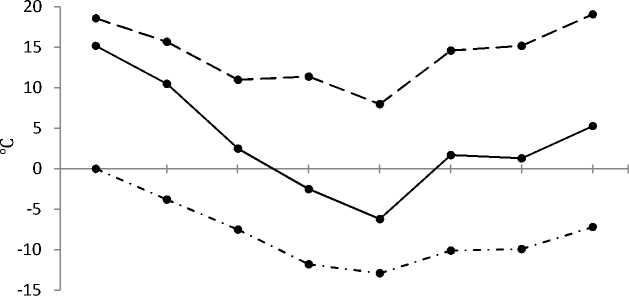
Nov.15 Dec. 01 Dec. 15 Jan. 01 Jan. 15 Feb. 01 Feb. 15 Mar.01 Investigate date minimal maximal average
Niitaka control
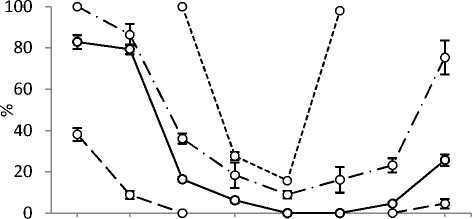

-10 -15 -20 -25
Investigation date
Figure 1 - Temperature conditions in winter period, Naju 2012-2013
Chuwhangbae control
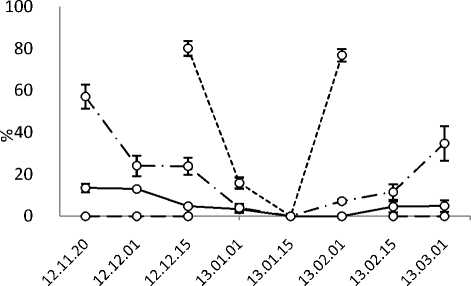
-10 -15
Investigation date

Investigation date
Investigation date
Figure 2 - Frost damages of flower buds in control and after artificial heating treatment (° C ) during winter period.
Data represented by Mean ± SD (n = 3)
A maximal cold resistance and minimal damaging in cultivars was identified under -10 and 15°C consequently regardless of treatment during January. By mid-January resistance of cultivars was higher respectively whereas the average and minimal air temperature of outside was reached -6.2 and -12.9°C. So, Chuhwangbae flower buds was tolerant and not injured in control by freezing till -20 and -25°C whereas in Niitaka was detected minimal damaging– 9.0 and 15.8% respectively. But in both cultivars floral organs damage was significantly differed from control under artificial heating state. Relatively vulnerable to frost was cultivar Niitaka which injury level was 47.6 and 96.3% respectively, in this case Chuwhangbae was differed with low level of injures- 9.9 and 28.4% respectively.
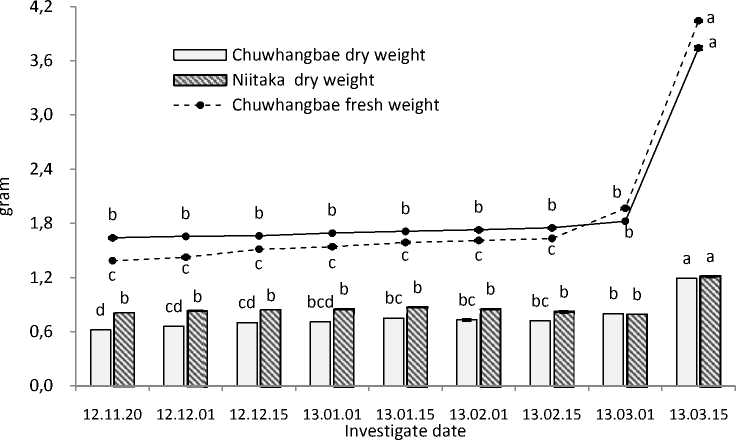
Figure 3 - In t en si t y of t he fl ow er bud s grow t h dur i n g w i nt er p er i od, g ( p er 10 bud s) . M ean s epar ati on w i t hin columns by Duncan’s test, P≤ 0.05
In subsequently by rising up of temperature in nature p e a r cu ltiv a r s cold tolerance was de cr e a se d a n d a s it w a s at th e b egin n ing of th e e n tr a n ce to th e d orm a n t p er io d le v e l o f the injury has been significantly increased, especially it w a s o b se r v e d d u r in g Feb r u a r y. And it related w ith b r eak in g of d o r m a n cy a n d in te n siv e ly d e v elo p m e n t of th e f lor a l orga n s ( Fig . 3), esp e cia ll y it w a s d e te cte d in Ch u w h a n gb a e w hi ch star te d to d e v e lo p e a r ly in co m p a r isi o n Niitaka. Thus, early February under negative temperature – 2 5° C w a s a lmo st c r itica l for both cultivars regardless of states where injury degrees in Niitak a r e ac h e d 1 0 0 % a n d in Chuwhangbae over 80%.
By early March in control Chuwhangbae and Niitaka was d et erm in e d the minimal injures under freezing till -10 ° C - 0.0 and 4.6% respectively, b u t un d e r A H sta te b oth cu l tiv a r s had a relatively high injures- 54.3 a n d 1 6 .4% r e spe ctiv e l y. B y r e d u cin g temp e r a tur e till - 20°C level of injures rapidly was increased, so i n co ntro l sta tes b oth cu ltiv a r s ha d a 3 4.8 a n d 7 5 .4% damages respectively, whereas in AH states all cultivars fully were d am ag e d .
So, regardless of cultivars the fr o st h ardin e ss r at e w a s sign i f ica n tly lo w bef o r e en ter t o the deep dormancy and after breakdown it, a maximal r e si st a nce to fr e e z in g w a s d e te rm in e d from late December till late January but th e d i ffe r e n ce of d am aging le v e l o f cu ltiv a r s h a v e been saved. Presumably from late December till late January w a s h o l d in g th e d e e p dormancy period in plants. Since in this peri o d w a s ob se r v e d th e le a st d e g r e e of d am ages but t h e d e e p d or m a ncy d u r a tio n a n d co ld to le r a nce lev e l w a s d iff er e n t in cu ltiv a r s r ega r d le s s of negative temperature. And pear cultivars si gn i f ica ntly r e a c t d i ff er e n tly t o th e pr o v o ca tiv e action of thaws. I t m ea ns th at Ch u w h a n gb a e r e sp o n d to e x te r n a l c o n d itio n p o sitiv e l y whereas Niitaka had negative responds to it with high level of injury.
On the base of our experience on study pear archespores development in spur shoots which was evaluated in Tashkent region (Uzbekistan) where had been determined different resistance of the cultivars to low temperature during winter (Rajametov and Baymetov, 2010) and concluded that the chilling requirement for blossoming is considered as an own features of cultivars. If the plants in the archespore stage or microspore formation stage can't get the requiring accumulated temperature, the development of floral organs get a bad effect under low temperature and then finally the flowering is delayed. And it should be noted that most of Central Asian and East Asian cultivars distinguished as low resistant to negative temperatures and more short rest period on compare European origin, where breakdown of the rest period Central and East Asian cultivars was observed in late January and they under preliminary hardening -20°C had about 78-80% significantly injury than European cultivars. Whereas in our work under Korean condition at the beginning of February under preliminary hardening -20°C East Asian cultivars Chuwhangbae and Niitaka had about 7-16% respectively moderate injury but under after artificial heating this trend was significantly higher 20-50% respectively, it means that plants is situated at the ready to develop of pollen cells but the external condition- low temperature hinders to it and the plants is under forced rest period. Subsequently by early March such as tendency are more significantly clearly expressed where under after artificial heating injury level was increased on comparison of control (in the field condition), where in Chuwhangbae injury level rapidly increased on compare Niitaka- 65-25% respectively. It means that the chilling requirements for blossoming in Niitaka is higher than Chuwhangbae and later start to develop but regardless of chilling requirements the difference of injury level are saved in cultivars.
Therefore in the future to give accurate and clearly conclusion about plant cold tolerance, to find out critical temperature and initial damaging of individual cultivars is necessary to carry out such as experiences more shorter period using minimum 7 or 10 days interval and wherever possible, complemented with clear priorities detailed studies on the passage of metabolism and physiological processes in plants during winter.
CONCLUSION
According to our results Chuwhangbae was distinguished more resistant to low negative temperature during winter period and under short period of heating or by fluctuation of temperature in natural condition it can save ability of resistance in comparison Niitaka. And cold resistant cultivar Chuwhangbae responds more sensitively to external environments. It means that with high rate it can realize hardening process by the restructuring of the plant protoplasts and the transition process to the new metabolic energy level by effecting negative temperatures. And we assume that it might be closely related with stage of dormancy, concentration of the mineral elements, water potential and transition processes of metabolism to the new energetic level.
In general, the mechanism of plant responses to the abiotic stresses such as frosts and to increase the tolerance of the plants- is a complex trait genetically programmed, but it manifests itself in certain environmental conditions. We assumed that this is mainly due to combined set of genes which, depending on the changes of the temperature effects on the metabolic functions and development phase of organs.
ACKNOWLEDGMENT
This research work was supported by fellowship funds of Pear research station, NHRI, RDA, Republic of Korea. The author thanks of the administration of RDA and technical staff for help to do this experience.
Список литературы Effect of the short period heating on cold resistant ability of the Asian pear cultivars Chuwhangbae and Niitaka during winter period
- Alehina N.D., Balnokin Y.V., Gavrilenko V.F. (2005) Plant Physiology. Moscow, Academia. PP. 640.
- Ashworth E.N., 1992. Formation and spread of ice in plant tissues. Hort. Rev. 13:215-255.
- Genkel P.A., Oknina E.Z., 1964. The rest period and cold resistance of plant. Moscow. PP. 244. (Russian).
- Grossi M., Cattivelli L., Terzi V., Stanca A.M. (1992) Modification of gene expression induced by ABA, in relation to drought and cold stress in barley shoots. Plant Physiol Biochem 30 97-103
- Guchapshev R.Kh., Satibalov A.V., 2006. Winter resistance of pear cultivars under condition of the foothills of the North Caucasus. «Methodological aspects of precision cultivation technology of fruit crops and grapes. T. I. Thematic collection of materials of the 75th Anniversary Conference SKZNIISiV. Krasnodar. PP. 171-175. (Russian)
- Gusta L.V., Trischuk R. and Weiser C.J., 2005. Plant Cold Acclimation: The Role of Abscisic Acid. J Plant Growth Regul 24:308-318
- Ingram J., Bartels D., 1996. The molecular basis of dehydration tolerance in plants. Annu Rev Plant Physiol Plant Mol Biol. 47:377-403.
- Kim Y.K., Kang S.S., Won K.H., Rajametov Sh.and Han J.H., 2012. Comparison of Freezing Hardness of Dormant shoots among Japanese Apricot cultivars. Abstracts Conference of the Korean Society for Horticultural Science, Spring 2012. Korean Journal of Horticultural Science & Technology, Vol. 30 Sup. I May. 2012, page(s) 114-114 (poster)
- Krasova N.G. 1997. Winter resistance of pear cultivars from VNIISPK. Abstract of scientific-methodological conference: «Improving Improving assortment and pear cultivation technology». -Orel, PP. 43-45. (Russian)
- Krasova N., Galasheva A., Golishkina L. and Yanchuk T. 2012. Effect of low temperature on cold resistant apple cultivars physiochemical composition. J.; Vestnik Orel GAU 3(96): 86-90.
- Lang V., Mantyla E., Welin B., et al., 1994. Alterations in water status, endogenous abscisic acid content, and expression of rab 18 gene during the development of freezing tolerance in Arabidopsis thaliana. Plant Physiol. 104, 1341-1349.
- Lata Ch. and Prasad M., 2011. Role of DREBs in regulation of abiotic stress responses in plants. Journal of Experimental Botany, Page 1 of 18
- Lee J.H, Yu D.J., Kim S.J., and Lee H.J., 2011. Changes of cold hardiness and carbohydrate content during cold acclimation in Highbush Blueberry (Vaccinium corymbosum). Conference of the Korean Society for Horticultural Science. Korean Journal of Horticultural Science & Technology, Vol. 29 Sup1. 2011. 10, page(s) 47 (Poster)
- Levitt J. 1980a. Responses of Plants to Environmental Stresses: Chilling, Freezing and High Temperature Stresses, Ed 2, Vol. 1.Academic Press, New York
- Likhonos F.D., Tuz A.S., Lobachev A.J., 1983. Flora of cultivated plants. XIV -POME FRUITS, Moskow. 126-225. (Russian).
- LIU Cong-xia, DENG Ming-jing, WANG Wen-feng, LI Yan-hui1, FENG Chen-jing, YANG Jin-min. 2007. The study on cold resistance of five species leaf-colored plants of Prunus [J]; Journal of Agricultural University of Hebei; 2007-05.
- Mohapatra S.S., Poole R.J., Dhindsa R.S.,1987. Changes in protein patterns and translatable messenger RNA populations during cold acclimation of alfalfa. Plant Physiol 82:733-733
- Nakashima K., Yamaguchi-Shinozaki K., 2010. Promoters and transcription factors in abiotic stress-responsive gene expression. In: Pareek A, Sopory S.K., Bohnert H.J., Govindjee, eds. Abiotic stress adaptation in plants, physiological, molecular and genomic foundation. Springer-Verlag, 199-216.
- Perras M, Sarhan F,. 1989. Synthesis of freezing tolerance proteins in leaves, crown and roots during cold acclimation of wheat. Plant Physiol 89: 577-585.
- Rajametov Sh., Baymetov K. 2010. Features of resistance of pear varieties to low temperatures. J.: Agro-ilm, Tashkent № 4 (16) 22-23.
- Rajametov Sh., Y.K. Kim., K.H. Won and S.S. Kang. 2011. Cold Resistance of Pear Cultivars in the Republic of Uzbekistan. Abstracts Conference of the Korean Society for Horticultural Science, Korean Journal of Horticultural Scielce & Technology, Vol. 29 Sup 2 2011. 10, page(s) 128-128
- Rezvyakova S. 2008. Cold resistance of pear cultivars P.ussuriensis. J.: Vestnik Orel SAU № 4: 86-90.
- Satibalov, A.V., T.Y. Bekkiev. 2008. Winter resistance of pear cultivars under condition of North-Caucasus region. J. Horticulture and viticulture. № 4. PP. 15-16.
- Shinozaki K, K.Yamaguchi-Shinozaki 1997. Gene expression and signal transduction in water-stress response. Plant Physiol. 115:327-334.
- Shinozaki K. and K.Yamaguchi-Shinozaki. 2000. Molecular responses to dehydration and low temperature: differences and cross-talk between two stress signaling pathways. Plant Biology, 3:217-223
- Shinozaki. K., K. Yamaguchi-Shinozaki and M. Seki. 2003. Regulatory network of gene expression in the drought and cold stress responses. Current Opinion in Plant Biology 6, 410-417.
- Sparks JP, Black RA.2000. Winter hydraulic conductivity and xylem cavitation in coniferous trees from upper and lower treeline. Arct Alp Res 32:101-106
- Sparks, Jed P., S. Gaylon, R. Campbell and Alan Black. 2001. Water content, hydraulic conductivity, and ice formation in winter stems of Pinus contorta: a TDR case study. Oecologia -127:468-475
- Sperry JS, Nichols KL, Sullivan JEM, Eastlack SE. 1994. Xylem embolism in ring-porous, diffuse-porous, and coniferous trees of northern Utah and interior Alaska. Ecology 75:1736-1752)
- Sperry JS. 1993. Winter xylem embolism and spring recovery in Betula cordifolia, Fagus grandifolia, Abies balsamea, and Picea Rubens. In: Borghetti M, Grace J, Raschi A (Eds) Water transport in plants under climatic stress. Cambridge University Press, New York, pp 86-98
- Steponkus PL and MS. Webb.1992. Freeze-induced dehydration and membrane destabilization in plants. In G Somero, B Osmond. Water and Life: Comparative Analysis of Water Relationshipsat the Organismic, Cellular and molecular Level. Springer-Verlag, Berlin, pp 338-362
- Sugiura, T., 2002: Dormancy and chilling requirement of deciduous fruit tree. Series of Agriculture Technology (fruit 8), 50:2-50.
- Thomashow, M.F. 1998. Role of cold-responsive genes in plant freezing tolerance. Plant Physiol. 118, 1-7.
- Thomashow, MF. 1999. Plant cold acclimation: freezing tolerance genes and regulatory mechanisms. Annu Rev Plant Physiol Plant Mol Biol. 50:571-599.
- Yamaguchi-Shinozaki K, Shinozaki K. 2005. Organization of cis-acting regulatory elements in osmotic-and cold stress-responsive promoters. Trends in Plant Science 10, 88-94
- Yim, S.H., J.H.Choi, J.J.Choi, S.S.Kang, Y.K.Kim and H.C.Lee. 2011. Freezing Hardness according to degree and duration of low temperature in pear cultivars. Conference of the Korean Society for Horticultural Science. Korean Journal of Horticultural Science & Technology, Vol. 29 Sup 2. 2011. 10, page(s) 120 (Poster)
- ZHANG Yong. 2006. Advance in the Response of Plants to Low Temperature Stress and Molecular Genetic Improvement. Journal of Anhui Agricultural Sciences-14
- Zhu JK. 2002. Salt and drought stress signal transduction in plants. Annual Reviews in Plant Biology 53, 247-273.

